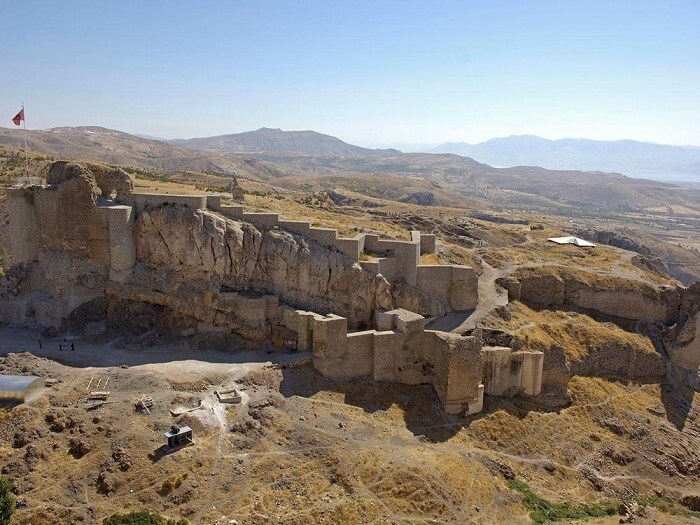By: Isis Davis-Marks | Smithsonian
Archaeologists in Turkey have unearthed a 2,800-year-old castle linked to Urartu, an ancient kingdom that spanned modern-day Armenia, eastern Turkey and northwestern Iran.
As Mesut Varol reports for the state-run Anadolu Agency (AA), experts discovered the ruins on a mountain in the Gürpınar district of eastern Turkey’s Van province. The find—made at an altitude of 8,200 feet—was part of an excavation project funded by Van Yuzuncu Yil University.
“Although it is believed to be dated back to the Urartian era like the Van Castle”—a nearby fortress built between the ninth and seventh centuries B.C.—“we see that it was mostly used in the Middle Ages,” excavation leader Rafet Çavuşoğlu, an archaeologist at the university, tells the AA.
Highlights of the discovery include a large cistern measuring roughly 21 feet deep, 21 feet long and 8 feet in diameter. The team also found ceramic artefacts and remnants of walls crafted out of limestone rock and sandstone.
“This castle is a very important discovery for us,” Çavuşoğlu says.
According to Encyclopedia Britannica, Urartu—located southeast of the Black Sea and southwest of the Caspian Sea—was an ancient civilization that first emerged in the early 13th century B.C. The Urartians wielded much political power in the Middle East during the ninth and eighth centuries B.C. but ultimately lost control of the region after multiple skirmishes with the Assyrian Empire.
In the seventh century B.C., the civilization seemingly vanished into thin air, likely as the result of an invasion by the Scythians, the Cimmerians or the Medes. Researchers only recognized Urartu as a distinct culture following digs conducted in the 19th century, as Mark Cartwright pointed out for World History Encyclopedia in 2018.
During their time in power, the Urartians were known for their impressive architectural projects, including a nearly 50-mile-long irrigation canal and ornately decorated temples. These religious structures were often outfitted with etchings that paid homage to local customs: The lion, for instance, was a popular Urartian motif, as Owen Jarus noted for Live Science in 2017.
Last year, the AA reported on a team of Turkish restorers who refurbished the stone carvings of the 2,700-year-old Ayanis Castle, which sits atop a hill overlooking Lake Van. One of the best-preserved heritage sites linked to the enigmatic civilization, the castle’s Haldi Temple housed walls decorated with “one-of-a-kind” intaglio ornaments, excavation leader Mehmet Işıklı, an archaeologist at Atatürk University, told the AA at the time.
Other recent finds related to Urartu range from the grave of a noblewoman buried with her jewellery at Çavuştepe Castle, also in Gürpınar, to a 2,800-year-old open-air temple at Harput Castle in the eastern Turkish province of Elazığ. In April, the Hurriyet Daily News reported that the temple—made up of an oval and flat area used to house sacrificial animals, as well as various niches, seats and steps—was likely used for major religious ceremonies honouring Haldi, the Urartian god of war.
12,000 Year Old Massive Underground Tunnels Are Real And Stretch From Scotland To Turkey
Because the region often experiences powerful earthquakes, few traces of Urartian buildings survive today, per World History Encyclopedia. Interestingly, Çavuşoğlu previously led an excavation at Çavuştepe Castle that suggested the Urartians used a construction technique called “locked stones” to protect their fortifications against tremors, as Daily Sabah reported in 2019.
Experts hope that the new find will shed light on Urartu culture and architecture.
“In cooperation with Van Yüzüncü Yıl University, we made an important discovery here. We found a new castle witnessing the Urartian period and the Middle Ages,” Gürpinar’s mayor, Hayrullah Tanis, tells the AA. “This discovery excites us in terms of tourism and culture.”
* * *
NEXT UP!
Magellan’s Strange Encounter With The 10-Foot Giants of Patagonia
IN 1520, FERDINAND Magellan took time out of his busy schedule of sailing around the world to stop in what is now Patagonia, where he found a naked giant dancing and singing on the shore. Magellan ordered one of his men to make contact (the unwitting emissary’s no doubt hilarious reaction to this sadly has been lost to history), and to be sure to reciprocate the dancing and singing to demonstrate friendship.
It worked. The man was able to lead the giant to a small island offshore, where the great captain waited. Describing the scene was a scholar along for the journey, Antonio Pigafetta, who kept a diary of the journey that was later turned into the book Magellan’s Voyage: A Narrative Account of the First Circumnavigation: “When he was before us, he began to marvel and to be afraid, and he raised one finger upward, believing that we came from heaven. And he was so tall that the tallest of us only came up to his waist,” and had a big, booming voice. The illustration above proves it—Patagonia was once inhabited by giants that positively dwarfed the heavenly Europeans that would come to conquer them.
Alright, maybe that isn’t airtight evidence. But it could well be that the people Magellan encountered, the Tehuelche, were indeed enormous, and that therefore this myth has some grounding in reality. And our trusty explorer would be damned if he wasn’t going to try to bring back evidence in pretty much the most obnoxious way you could imagine.
* * *
READ MORE: 200,000 Year Old Ancient Anunnaki City Discovered In South Africa
Read more on Ancient History: These 4 Ancient Civilizations Existed On Earth Long Before Human Race
Telegram: Stay connected and get the latest updates by following us on Telegram!
We’d love to hear from you! If you have a comment about this article or if you have a tip for a future Collective Spark Story please let us know below in the comment section.

